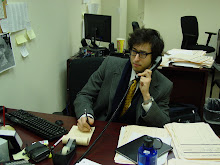We're in the thick of it now. Candidate profiles are dropping like domino chips in the games at Maria Hernandez Park (also like the dice in the games on the alley around my block). I've got Doug Biviano, Steve Levin, Gerry Esposito, Maritza Davila, Isaac Abraham, and others coming soon, in addition to the Evan Thies profile that ran two weeks ago. Last week was Jo Anne Simon's turn, fresh off a spat with Doug Biviano (aka Superfreak vs. Can't Touch This). There have been a few other profiles too, including Theodore Hamm's Q and A in The Brooklyn Rail, Reid Pillifant's look at Simon and Sotomayor on PolitickerNY, and, on the more anonymously critical side, a series of posts coming from a new blog site called realreformbrooklyn. Below is my Jo Anne profile. Superfreaky.
At the corner of Pacific and Bond Street, an inch of cement pokes out above the street, where a flattened curb cut should be.City Council candidate and Boerum Hill resident Jo Anne Simon, 56, pokes at the curb with her shoe and scowls.
“A wheelchair can’t go up this angle. It would be impossible,” said Simon. “The only way to fix this is to raise  the street.The owner is willing to replace the curb cut, but he can’t get to the street because the city oversees that.”
the street.The owner is willing to replace the curb cut, but he can’t get to the street because the city oversees that.”
 the street.The owner is willing to replace the curb cut, but he can’t get to the street because the city oversees that.”
the street.The owner is willing to replace the curb cut, but he can’t get to the street because the city oversees that.”It is just one corner on a quiet street in Boerum Hill, half a block from Simon’s home, but Simon notices these details.She notices which commercial buildings do not have elevators and subway stops do not have adequate access for disabled individuals.
“Improving the pedestrian experience is a good thing, but I think it’s an issue that appears on people’s radar screen who don’t normally think about curb cuts,” said Simon.“No one thinks about curb cuts until you need them.”
Improving sidewalk accessibility is one of several aspects of Simon’s 30-year career of disability advocacy.Born in Yonkers and attending a Catholic girls’ high school in the Bronx, Simon went to Gallaudet University in Washington, DC, where she pursued a career educating and advising deaf children.
“I used to take books to a synagogue in DC and women would Braille them by hand.It took months,” said Simon.“
The advent of the computer has changed that.”In 1981, Simon moved to Brooklyn, settling in Boerum Hill (where she still lives, with her husband, two stepsons, and two grandchildren). Law school at Fordham University soon followed, but she continued working with the disabled, this time representing individuals filing lawsuits against building owners or city agencies for not providing equal access or equal treatment.
After law school, she served as president of the Boerum Hill Association from 1993 to 1999, as a member of the Gowanus Community Stakeholder Group and as Democratic District Leader for the 52nd Assembly District, giving her wider exposure to political life in Brownstone Brooklyn.
She has never left the field of education though, representing special education students who were  discriminated against. Simon knows special education can be expensive, but it is a priority of hers that public school children receive an equal opportunity for high-quality education no matter whether they are differently abled.
discriminated against. Simon knows special education can be expensive, but it is a priority of hers that public school children receive an equal opportunity for high-quality education no matter whether they are differently abled.
“Having been a teacher for the deaf, I know that language is the most important thing,” said Simon. “Students need special programs that give them the tools to communicate.We have to look at how we are funding what we are funding.”
 discriminated against. Simon knows special education can be expensive, but it is a priority of hers that public school children receive an equal opportunity for high-quality education no matter whether they are differently abled.
discriminated against. Simon knows special education can be expensive, but it is a priority of hers that public school children receive an equal opportunity for high-quality education no matter whether they are differently abled.“Having been a teacher for the deaf, I know that language is the most important thing,” said Simon. “Students need special programs that give them the tools to communicate.We have to look at how we are funding what we are funding.”
One of Simon’s ideas is to look more closely at organizational and administrative records, particularly regarding language and speech training.Simon wants more oversight of special education programs citywide, which she sees promoting if elected to City Council.
“Some school districts bill on Medicaid speech therapy once a week for an hour instead of two times a week for half an hour.That’s not the same thing,” said Simon.
Transportation, particularly improving accessibility at subway stations and protecting bus lines, is another significant area where Simon wants to focus her advocacy.She has been a constant presence at MTA hearings this spring, and is monitoring changes in Access-a-ride and Brooklyn’s bus lines closely, as they often are the only means of transportation for disabled individuals.
“If you get on the F at Jay Street, the next accessible subway stop is Coney Island,” she said.
Simon speaks about improving air quality and reducing environmental toxins such as lead, cadmium and mercury which can lead to learning disabilities in children.For Simon, advocacy on environmental, transportation, and education issues are all connected, and they affect all the constituents in her district, abled and disabled.
“People with disabilities don’t have many friends,” said Simon. “It’s easy to overlook those issues.Working with people with disabilities, you realize that many of the ‘one size fits all’ policies are ineffective and inequitable.”


No comments:
Post a Comment